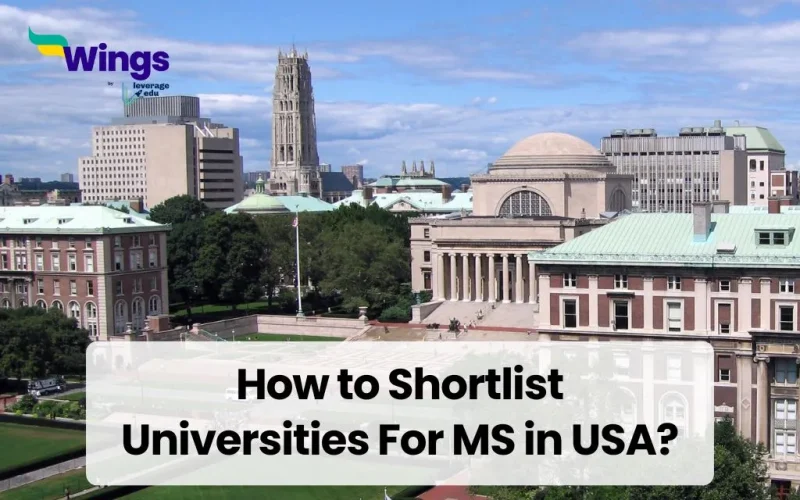Studying abroad can be a daunting task as there is so much to consider and plan. Choosing the right university is one of the important decisions you need to make when planning your study abroad journey. If you are planning to pursue MS in the USA then here are some factors to keep in mind before shortlisting universities. Every year thousands of students apply to get enrolled, but due to improper guidance, they get rejected. In this blog, we will cover all important aspects of choosing the right university for MS in USA.
This Blog Includes:
- Why Is Shortlisting Important for MS in the USA?
- How to Shortlist Universities for MS in the USA?
- How Many Universities Should I Shortlist?
- When To Apply for MS in the USA: Fall or Spring Intake?
- How to Apply For MS in the USA?
- How Do US Universities Shortlist Applicants?
- Top Universities for MS in the USA
- Other Ways to Shortlist MS Universities in the USA
- FAQs
Why Is Shortlisting Important for MS in the USA?
Shortlisting is a key step when planning to study MS in the USA. With over 1,000 universities offering master’s programs, applying without a clear plan can lead to wasted time, money, and effort. A smart shortlist helps you focus on universities that match your goals, budget, and academic profile. It also improves your chances of getting accepted and possibly receiving scholarships or assistantships. Most importantly, it helps you stay organized, meet deadlines, and avoid unnecessary application costs.
How to Shortlist Universities for MS in the USA?
To shortlist the right universities for your MS in the USA, you need to match your academic profile with what each university expects. Here are the most important factors to consider:
1. Course Specialization
Check if the university offers your preferred specialization. For example, if you’re interested in Data Science, look for universities known for AI, machine learning, or analytics.
2. University Ranking and Reputation
Look at global and subject-specific rankings (QS, THE, or U.S. News). Higher-ranked universities often have better research, faculty, and job opportunities.
3. Academic Requirements
Match your GPA, GRE/GMAT scores, and English test scores (TOEFL/IELTS) with what the university asks for.
4. Tuition Fees and Living Costs
Cost of study varies widely. Public universities are generally more affordable than private ones. Don’t forget to consider living expenses in cities like New York or San Francisco vs smaller towns.
5. Scholarships and Financial Aid
Check if the university offers need-based or merit-based scholarships. Some universities provide assistantships or fee waivers.
6. Location and Job Opportunities
Choose locations with good internship and job prospects in your field. Cities with strong tech, finance, or healthcare industries offer more chances after graduation.
7. Acceptance Rate
Some universities are highly competitive. It’s good to have a mix of dream, target, and safe options.
8. Alumni Network and Career Support
Strong alumni and career services can help you get internships, mentorship, and job placements.
Use Smart Tools
If you’re not sure where to start, you can use Leverage Edu’s AI University Course Finder. It matches your profile with top universities based on your preferences for course, country, and budget, making the shortlisting process much easier.
Check it Out: Cost Of Living Calculator
How Many Universities Should I Shortlist?
Applying to Top Universities in the USA for MS can cost you a huge amount. Most students apply to 6 to 12 universities for MS in the USA. Because This gives you a safe and smart mix of options based on your profile. Here’s how to divide them:
- These are top-ranked or highly competitive universities where your chances are low but still possible. You can include 3 to 4 of these as your dream options.
- These are universities that match your academic profile well. You have a decent chance of getting in. Include 3 to 4 of these as your target options.
- These have higher acceptance rates and are considered safer choices. You’re likely to get an admit from these. Add 2 to 4 of these to your list.
Note: Applying to too few can be risky, and applying to too many can become stressful and expensive. A balanced list helps you stay in control and improves your chances.
Also Read: A Guide to Study in America for Free
When To Apply for MS in the USA: Fall or Spring Intake?
In the USA, most universities offer two main intakes for MS programs: Fall and Spring. Choosing the right intake depends on your readiness, preferred universities, and available courses.
- Fall intake starts around August or September. It is the most popular and widely preferred intake. Most universities offer a full range of courses, scholarships, and assistantships during this time.
- Spring intake begins around January. Fewer universities and programs are available, and some scholarships or internships may be limited. However, it has fewer applicants, so competition is slightly lower.
Also Read: Which is The Best Intake for USA Universities?
How to Apply For MS in the USA?
Here’s a step-by-step guide to help you apply for MS in the USA:
Step 1- Arrange all the documents required from the list mentioned below.
- Academic Transcripts
- Passport
- Visa
- Updated CV/Resume
- English Language Proficiency Test Scores
- Letter of Recommendations
- Statement of Purpose
- TB Test Certificate for UK Universities
- Financial Evidence
Step 2- Visit the official website of the university and select the Apply Now section. Click “Apply Now” and select a post-graduation program to proceed.
Step 3- Do not get bored and have patience. It is important as you need to submit a long form. Do not hurry and fill in every detail correctly.
Step 4- Submit the form with documents and make payments.
Tip: Get a forex card first. Forex cards can save you 5% on every transaction in foreign currency. Also, they may give you some cashback. On the other hand, paying with a credit card is nothing less than expensive. It charges you a few percent to make transactions in foreign currency. You can also use our Fly Forex services to make quick transactions abroad.
How Do US Universities Shortlist Applicants?
Universities in the USA evaluate your entire profile before offering admission to an MS program. They look at how well you match their program expectations and values. Here are the main things they consider:
- Your academic record in your undergraduate degree is one of the first things they check. They look for consistent scores and strong performance in subjects related to the course you are applying for.
- Standardized test scores like GRE, GMAT, TOEFL, or IELTS help them compare you with students from other countries and education systems.
- Work experience, internships, research papers, and academic projects show how much practical knowledge and interest you have in your field.
- Your Statement of Purpose (SOP) explains why you want to do the course, how it connects to your goals, and why that university is the right fit.
- Letters of Recommendation (LORs) from teachers or employers help the university understand how others view your skills and potential.
- Extracurricular activities such as leadership roles, volunteering, or clubs show that you’re an active and well-rounded person.
Also Read: Choosing the Best Intake for International Students in USA 2025
Top Universities for MS in the USA
Better infrastructure and ample job opportunities are major reasons why the USA is one of the most preferred study destinations. There are some best universities for MS in the USA where students can apply for a better future. Here are the best universities to pursue MS in the USA:
- Massachusetts Institute of Technology (MIT)
- Stanford University
- University of Pennsylvania
- Princeton University
- Yale University
- Cornell University
- Columbia University
- Harvard University
- California Institute of Technology
- University of Chicago
Other Ways to Shortlist MS Universities in the USA
Apart from the above-mentioned criteria, there are other parameters that you should consider for shortlisting universities for MS in the USA.
Based on Standardized Test Scores
You can select universities depending on your GRE, TOEFL, or IELTS scores. These scores help universities compare applicants from different academic backgrounds and are often used to filter candidates during the shortlisting process.
Based on Tuition Fees and Living Costs
Cost plays a big role in deciding where to apply. Some universities have high tuition fees and are located in expensive cities, while others are more budget-friendly. Shortlisting based on your financial capacity helps you avoid last-minute stress during the application or visa stages.
Based on Career Goals and Industry Links
Look at how well the program connects with your future job goals. Some universities have strong links with specific industries or offer great on-campus placements and internships in your field.
Based on Location
Choose locations where your field is in demand. For example, tech students may prefer cities like San Jose or Seattle, while mechanical or automotive students may choose Michigan or Ohio.
Based on Alumni Reviews and Student Feedback
Connect with alumni or current students to get real insights into the course, professors, job support, and campus life. Their experience can help you understand if the university matches your expectations.
Using Smart Tools like AI Course University Finder
If you want a faster and more reliable method, use Leverage Edu’s AI University Course Finder. This tool automatically generates a list of best-fit universities based on your academic profile, course preference, and study destination. It removes the guesswork and gives you a data-backed shortlist within minutes, saving time and improving your chances.
Check it Out: Universities in USA
FAQs
Ans. You should select universities based on factors like course specialization, location, tuition fees, rankings, and your academic profile. Using tools like the AI Course University Finder can make this process faster and more accurate.
Ans. Check each university’s official website for program-specific requirements such as minimum GPA, GRE/GMAT scores, English language test scores, and work experience (if needed). Some programs may also ask for a Statement of Purpose and Letters of Recommendation.
Ans. Most good universities in the USA prefer a minimum CGPA of 7.0 out of 10. However, top universities may expect 8.0 or higher, especially for competitive programs.
Related Reads
Shortlisting the right universities for your MS in the USA is not just about rankings but it’s about finding the best fit for your academic background, budget, goals, and timeline. A well-balanced shortlist increases your chances of admission, reduces unnecessary expenses, and helps you stay focused throughout the application process.
If you’re unsure where to begin, Leverage Edu’s AI Course University Finder can make things easier. It uses your profile details to generate a smart, customized list of universities across the USA that match your preferences and strengths. From shortlisting to SOPs, LORs, and visa support, Leverage Edu guides you every step of the way.
 One app for all your study abroad needs
One app for all your study abroad needs















 60,000+ students trusted us with their dreams. Take the first step today!
60,000+ students trusted us with their dreams. Take the first step today!